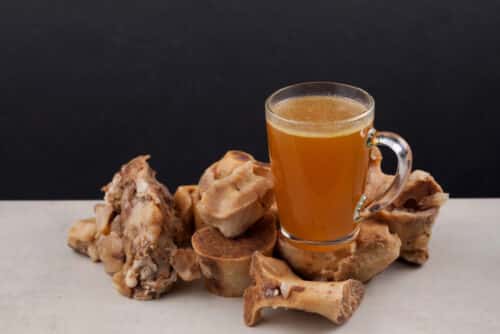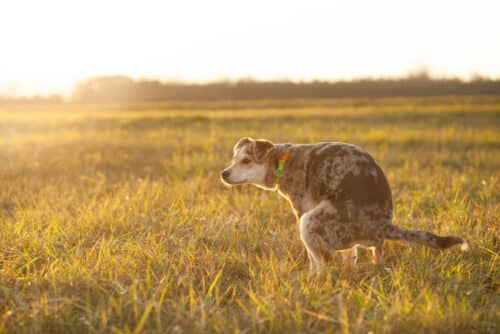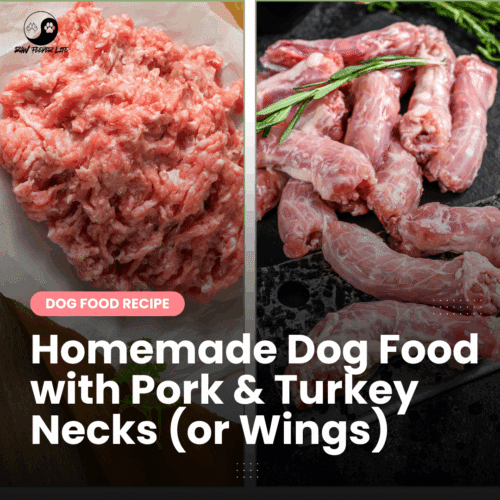Keep the Tail Wagging is supported by pet parents. I occasionally earn a commission (at no additional cost to you) when you click through an affiliate link to one of my favorite products. Thank you for your support. Read More
In 2023, I was introduced to Gussy's Gut, a supplement formulated in collaboration with Dr. Ian Billinghurst and Rob Ryan. Gussy's Gut is a fermented, freeze-dried powder made from 19 superfoods. It contains 180 powerful nutrients, including pre- and probiotics, that dogs struggle to obtain from synthetic supplements. This supplement helps dogs build a healthy gut microbiome, robust immune system, and overall well-being.
At the time of this review, I've been adding Gussy's Gut to my dogs' meals for nearly twelve months. This article will explore fermented foods' ingredients, benefits and risks, and my experience.
Gussy's Gut Ingredients
Gussy's Gut boasts a carefully selected blend of high-quality ingredients crucial in promoting a healthy gut microbiome in dogs.
Active Ingredients: cabbage, cauliflower, broccoli, cilantro, parsley, kale, mustard greens, artichoke, dandelion turmeric, papaya, red beets, milk thistle, oregano, wild blueberries, alfalfa, decaffeinated green tea, grass-fed goat kefir, kelp
Inactive Ingredients: sea salt, white cheddar and/or parmesan
Benefits of Gussy's Gut for Dogs
Fermentation is a process in which bacteria break down starch and sugar. Common fermented foods include kefir, kombucha, sauerkraut, and yogurt.
Fermented foods, like Gussy's Gut, offer several benefits for dogs:
- improved digestion
- enhanced nutrient absorption
- blocks antinutrients (which may interfere with nutrient absorption)
- promotes a robust immune system
- reduced inflammation
Gussy's Gut sources ingredients from organic and biodynamic (a holistic, ecological, and ethical farming approach), removing the concern about pesticides commonly found in US produce.
My Thoughts on Gussy's Gut
My dogs don't have an issue with Gussy's Gut. I've mixed it into their meals, used it as a meal topper, and added a hydrated teaspoonful to their dishes. My dogs eat it every time.
I was excited to try Gussy's Gut because I was attracted to the ingredients and the idea of adding a non-dairy fermented whole food to my dogs' diet. I was surprised by the cost; however, I've found that one teaspoon of Gussy's Gut was more than enough for each dog. A bag lasts up to three months with my three large dogs, bringing the cost down to $30/month ($10 per dog).
By switching to Gussy's Gut (and a couple of other supplements), I could reduce the number of supplements I add to my dogs' diet. I don't use Gussy's Gut exclusively because rotating probiotics in my dogs' diet encourages a diverse population of bacteria.
Other Supplements I Add to My Dogs' Diet
I used to have a box full of supplements I added to my dogs' diet. Since I began using Gussy's Gut, I started rethinking the supplements and now have a small amount that works for my dogs:
Risks of Gussy's Gut and Other Fermented Foods
I'm overjoyed by my dogs' experience with Gussy's Gut, and it's tempting to recommend this product to everyone dealing with any canine health issue. However, fermented foods aren't for every dog.
Wasting Food, Time, and Money
Frankly, your dog might not like the taste or smell of fermented foods. When I was new to fermenting, I wanted to dive headfirst into making homemade ferments. I learned to start slowly by purchasing commercial fermented products with dog-safe ingredients before I began making homemade blends.
My dogs don't have an issue with the taste or smell of Gussy's Gut; none goes to waste.
DIY Fermented Blends are Easy and Hard
Fermenting is easy – more straightforward with the right tools. But I lost a couple of jars because I didn't seal them properly, and I learned that fermented spinach smells awful. Gussy's Gut is effortless – I split one tablespoon between my three dogs several days weekly.
Fermented Foods May Cause Gas and Bloating
Dogs not used to consuming fermented foods or with digestive issues may initially experience an adverse reaction, including gas, bloating, loose stool, or diarrhea. Dog owners may want to start with a small amount and slowly increase the amount of ferment while monitoring the dog's response.
I find it easier to mix fermented foods into my dogs' meals, but there are some fermented products that my dogs will consume straight – kefir, raw goat's milk, fermented fish bone broth, and Gussy's Gut (hydrated and placed as a dollop on my dogs' dishes).
Gussy's Gut doesn't cause gas or bloating in my dogs.
Gussy's Gut isn't For All Dogs
Histamine, Mast Cell Tumors, and Yeast Overgrowth
There are three canine health concerns that may not be a good match with fermented foods. Rob Ryan, founder of Gussy's Gut, shared the following:
“We prefer customers not start Gussy's Gut if your dog is compromised or you are worried about yeast overgrowth, histamine intolerance, or MCTs. For two reasons. We do not want Ever to be the cause of any discomfort in any dogs even if there is just a 1% chance fermented foods can cause an issue. Why take that 1% chance? Fermented superfoods are an amazing addition after resolving these health issues or disease states. We're not a therapeutic (or treatment) supplement. We support wellness and balance.“
Histamines and Dogs
Histamines are chemicals a dog's immune system produces in response to allergens or certain inflammatory triggers. Histamines play a crucial role in the body's defense against pathogens and regulating various physiological processes. However, in some cases, dogs may have an overproduction or hypersensitivity to histamines, leading to allergic reactions or other health issues.
Causes of histamine release in dogs can vary and may include:
- Allergies: Dogs may develop histamine-related symptoms in response to environmental allergens (e.g., pollen, dust mites), food allergies, or insect bites.
- Infections: Histamines are also released as part of the body's response to infections caused by bacteria, viruses, or parasites.
- Stress: Emotional stress or anxiety can trigger histamine release in some dogs, exacerbating allergic reactions or skin conditions.
Feeding fresh food that includes dog-safe, low-histamine foods. Avoiding fermented and other high-histamine foods.
Of course, it's helpful to work closely with a holistic veterinarian or a canine nutritionist when making dietary changes for dogs with histamine-related issues.
Mast Cell Tumors and Dogs
A mast cell tumor in dogs is a type of cancerous growth originating from mast cells, a type of immune cell found throughout the body, particularly in the skin and mucous membranes. Mast cell tumors can vary in appearance, size, and aggressiveness, ranging from benign (low-grade) to malignant (high-grade) forms.
Mast cell tumors (MCTs) account for approximately 16-21% of all canine cancer cases, making them one of the most common types of skin tumors in dogs. While the traditional veterinarian community doesn't fully understand the exact cause of mast cell tumors in dogs, I've read that several factors may contribute to their development, including genetic predisposition, exposure to certain chemicals or toxins, and immune system dysfunction.
It is essential to examine our dogs when grooming and petting regularly. I categorize my dogs' lumps and bumps and note their size, feel, and location, which I discuss with our veterinarian.
Yeast Overgrowth and Dogs
Yeast overgrowth in dogs refers to the excessive proliferation of yeast on a dog's skin, paws, or ears. The yeast commonly found on a dog's skin is typically harmless in small quantities but can multiply rapidly under certain conditions, leading to skin infections and other health issues.
Factors contributing to yeast overgrowth in some dogs include:
- high-carbohydrate diets
- weakened immune systems
- the skin folds in a manner that traps moisture, creating a favorite environment for yeast overgrowth
- living in warm, humid climates may also encourage yeast proliferation
Signs that a dog may have yeast overgrowth include:
- signs of irritation, redness, inflamed skin, constant scratching and itching
- a musty or yeasty smell on the paws, skin, or ears
- excessive oily skin and coat, especially around the ears, paws, or skin folds
- hair loss in areas due to yeast/itching
Treatments to eliminate yeast overgrowth in dogs include:
- switching to a diet of fresh food or raw; these diets are high protein and low-carb, reducing the sugar levels, starving yeast, and limiting its growth
- topical treatments like medicated wipes, shampoos, paw cleaners, or ear cleaners formulated to target yeast and eliminate excess
- veterinarians may prescribe antifungal medications and topical treatments to combat the yeast overgrowth
- NATURAL PRODUCTS that combat yeast overgrowth include:
- Yeasty Beast Protocol by Adored Beast Apothecary
- Topical Yeast Spray for Dogs by Adored Beast Apothecary
- Colloidal Silver Spray, Long Living Pets
- CocoTherapy Coconut Oil (natural topical treatment)
Consult a veterinarian for an accurate diagnosis and an appropriate treatment plan tailored to your dog's needs.
Final Thoughts on Gussy's Gut
Like many supplements on the market, Gussy's Gut won't be a good fit for every dog due to certain health issues or the taste. Because it's made with organic, whole food ingredients, I prefer it to many other options and keep it in the rotation for my dogs. I've seen benefits with each of my dogs, including healthy stools and decreased symptoms of leaky gut.
I've found that a small amount goes a long way with my dogs, and decreasing the serving amount allows a bag to stretch to nearly three months with my dogs.
Due to the success we've experienced with Gussy's Gut, I now rotate it with other trusted probiotics to encourage a varied and healthy gut microbiome for my dogs.






